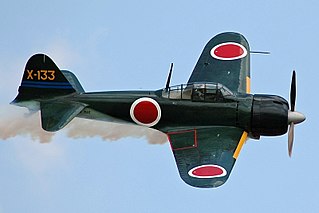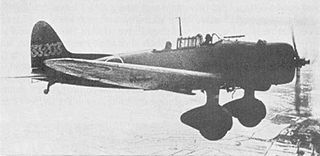
The Mitsubishi A5M, formal Japanese Navy designation Mitsubishi Navy Type 96 Carrier-based Fighter (九六式艦上戦闘機), experimental Navy designation Mitsubishi Navy Experimental 9-Shi Carrier Fighter, company designation Mitsubishi Ka-14, was a Japanese carrier-based fighter aircraft. It was the world's first monoplane shipboard fighter to enter service and the direct predecessor of the famous Mitsubishi A6M "Zero". The Allied reporting name was Claude.

The Yokosuka (横須賀)D4YSuisei Navy Carrier dive bomber was operated by the Imperial Japanese Navy. Its Allied reporting name was "Judy". The D4Y was one of the fastest dive bombers of the war and only the delays in its development hindered its service while its predecessor, the slower fixed-gear Aichi D3A, remained in service much longer than intended. Despite limited use, the speed and the range of the D4Y were nevertheless valuable, and the type was used with success as reconnaissance aircraft as well as for kamikaze missions.

The Mitsubishi J2M Raiden is a single-engined land-based fighter aircraft used by the Imperial Japanese Navy Air Service in World War II. The Allied reporting name was "Jack".

The Bougainville Campaign was a series of land and naval battles of the Pacific campaign of World War II between Allied forces and the Empire of Japan. It was part of Operation Cartwheel, the Allied grand strategy in the South Pacific. The campaign took place in the Northern Solomons in two phases. The first phase, in which American troops landed and held the perimeter around the beachhead at Torokina, lasted from November 1943 through November 1944. The second phase, in which primarily Australian troops went on the offensive, mopping up pockets of starving, isolated but still-determined Japanese, lasted from November 1944 until August 1945, when the last Japanese soldiers on the island surrendered. Operations during the final phase of the campaign saw the Australian forces advance north towards the Bonis Peninsula and south towards the main Japanese stronghold around Buin, although the war ended before these two enclaves were completely destroyed.

Lieutenant Junior Grade Hiroyoshi Nishizawa was an ace of the Imperial Japanese Navy Air Service during World War II.

The Mitsubishi G3M was a Japanese bomber and transport aircraft used by the Imperial Japanese Navy Air Service (IJNAS) during World War II.
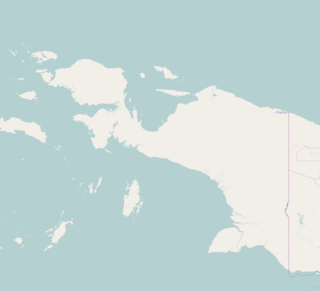
Frans Kaisiepo International Airport, is an airport in Biak, Papua, Indonesia. It is also known as Mokmer Airport. The airport is named after Frans Kaisiepo, the fourth Governor of Papua. The airport has seven aircraft parking slots, of which two are capable of handling wide-body aircraft, and a small terminal without jet bridges. The airport's only runway is 3,571m long, designated as 11/29.

Buka Airport is an airport serving Buka Island in the Autonomous Region of Bougainville in Papua New Guinea.
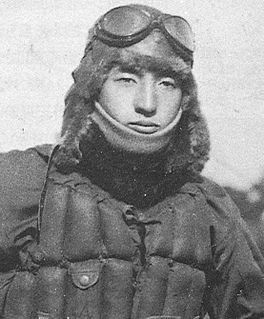
Warrant Officer Kenji Yanagiya was a member of the Imperial Japanese Navy's Zero fighter aces who fought the Battle of Solomon Islands in October 1942 – June 1943. He is best known as the only escort fighter pilot of the Yamamoto mission to survive the war.

Fenton Airfield was a World War II military airfield located at Tipperary Station, Hayes Creek, Northern Territory, Australia and named after flight lieutenant Clyde Fenton.

Long Airfield was a World War II military airfield located in the locality of Douglas-Daly, Northern Territory, Australia.
Vunakanau Airfield was an aerodrome located near Vunakanau, East New Britain, Papua New Guinea. The airfield was constructed as a Royal Australian Air Force aerodrome and consisted of an unpaved single runway during World War II. The airfield was captured during the battle of Rabaul in 1942 by the Imperial Japanese and was extensively modified and expanded. Vunakanau was later neutralized by Allied air bombing from 1944.

Eagle Farm Airport was a small airport located 6 km (3.7 mi) north-east of Brisbane in the suburb of Eagle Farm, Queensland, Australia.
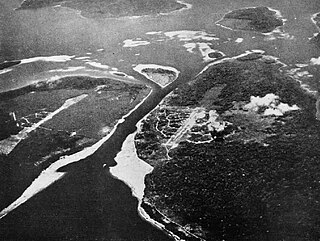
Between 9 March and 5 April 1942 during World War II, forces of the Empire of Japan occupied the islands of Buka and Bougainville in the South Pacific. At that time these islands were part of the Australian-administered Territory of New Guinea. A platoon of Australian commandos from the 1st Independent Company was located at Buka Airfield when the Japanese landed but did not contest the invasion.

Operation I-Go was an aerial counter-offensive launched by Imperial Japanese forces against Allied forces during the Solomon Islands and New Guinea Campaigns in the Pacific Theater of World War II from 1–16 April 1943. In the operation, Japanese aircraft—primarily from Imperial Japanese Navy units under the command of Admirals Isoroku Yamamoto and Jinichi Kusaka—attacked Allied ships, aircraft, and land installations in the southeast Solomon Islands and New Guinea. The goal of the operation was to halt the Allied offensives in New Guinea and the Solomons and to give Japan time to prepare a new set of defenses in response to recent defeats to the Allies in the Battle of Guadalcanal and in New Guinea at Buna–Gona, Wau, and the Bismarck Sea.
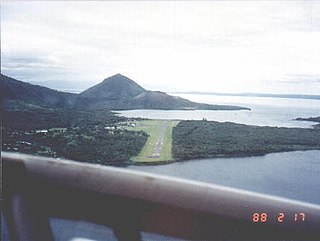
Lakunai Airfield was an aerodrome located near Rabaul, East New Britain, Papua New Guinea. The airfield was later known as Rabaul Airport. It is located at the foot of Tavurvur volcano, near Matupit Island. The airport was destroyed by the 1994 eruption that destroyed the town of Rabaul and subsequently the new airport was built and opened at Tokua, on the opposite side of the Rabaul caldera. The former airport was located at 04°13′S152°11′E.
Tobera Airfield was an aerodrome located near Tobera, near Keravat, East New Britain, Papua New Guinea. The airfield was constructed by the Imperial Japanese in World War II during August 1943. Tobera was later neutralized by Allied air bombing from 1944. The airfield was abandoned after the cessation of hostilities.

Aropa Airport is an airport in Kieta, Bougainville Island, Papua New Guinea.
Buin Airport (IATA:UBI) was an airport located near Kara, Bougainville Island, Papua New Guinea.





